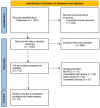Efficacy of non-pharmacological interventions for primary dysmenorrhoea: a systematic review and Bayesian network meta-analysis
- PMID: 38242565
- PMCID: PMC11137453
- DOI: 10.1136/bmjebm-2023-112434
Efficacy of non-pharmacological interventions for primary dysmenorrhoea: a systematic review and Bayesian network meta-analysis
Abstract
Objectives: To assess the relative benefits of various non-pharmacological interventions on treating primary dysmenorrhoea within a network meta-analysis.
Study design: Systematic review and Bayesian network meta-analysis.
Inclusion criteria: Randomised controlled trial involving patient with primary dysmenorrhoea and received non-pharmacological interventions.
Data sources: Four databases (Medline, Embase, Cochrane Library and Web of Science) were searched from inception to October first, 2022.
Risk-of-bias rob assessment: RoB 2.0 assessment tools was used to assess the risk of bias in the included studies.
Synthesis of results: Conventional meta-analysis was conducted by pairwise comparison between non-pharmacological therapy and control treatment. The Bayesian network meta-analysis was conducted by the Aggregate Data Drug Information System Software based on the consistency or inconsistency model, and rank probability was used to indicate the priority of non-pharmacological therapy.
Results: 33 studies involving eight non-pharmacological interventions were included. With regard to conventional meta-analysis, we selected Visual Analogue Scale (VAS) as primary outcome to evaluate the pain intensity. The result showed that eight interventions (Exercise, Herb, Acupuncture, Aromatherapy, Transcutaneous Electrical Nerve Stimulation, Topical heat, Acupressure, Yoga) displayed positive effect on reduction of menstrual pain compared with placebo or no treatment. A Bayesian network meta-analysis revealed that exercise -3.20 (95% CI -4.01 to -2.34), acupuncture -2.90 (95% CI -3.97 to -2.85) and topical heat -2.97 (95% CI -4.66 to -1.29) probably resulted in a reduction in pain intensity (VAS) .
Conclusions: Non-pharmacological interventions may result in a reduction or slight reduction in pain intensity compared with no treatment or placebo. Specifically, exercise and acupuncture are considered as potentially effective non-pharmacological treatments in short-term treatment. Indeed, larger and better methodological quality research is needed.
Trial registration number: CRD42022351021.
Keywords: acupuncture; women's health.
© Author(s) (or their employer(s)) 2024. Re-use permitted under CC BY-NC. No commercial re-use. See rights and permissions. Published by BMJ.
Conflict of interest statement
Competing interests: None declared.
Figures




References
Publication types
MeSH terms
LinkOut - more resources
Full Text Sources
Medical
Research Materials
